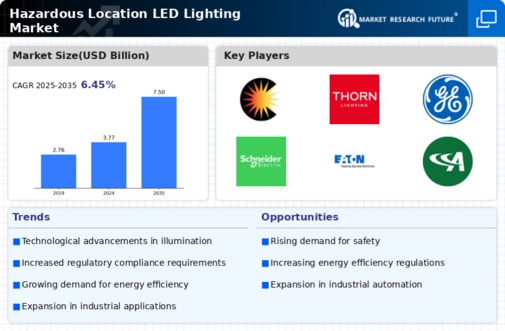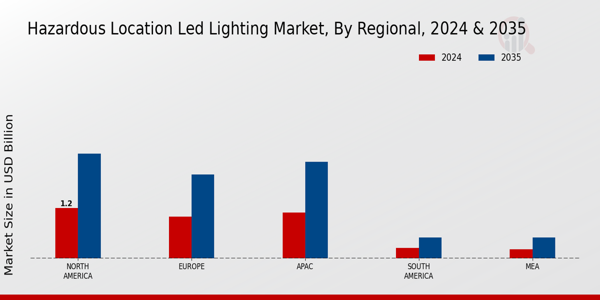Market Growth Charts
Technological Advancements
Technological advancements in LED lighting technology are driving the Global Hazardous Location LED Lighting Market Industry. Innovations such as improved energy efficiency, longer lifespan, and enhanced durability make LED lighting an attractive option for hazardous locations. These advancements enable manufacturers to produce lighting solutions that can withstand extreme conditions, such as high temperatures and corrosive environments. Furthermore, the integration of smart technologies, such as IoT connectivity, allows for real-time monitoring and control of lighting systems. This trend is likely to propel the market forward, as industries seek to leverage these technologies to optimize operations and reduce maintenance costs.
Increased Safety Regulations
The Global Hazardous Location LED Lighting Market Industry is significantly influenced by stringent safety regulations imposed by governmental bodies. These regulations mandate the use of explosion-proof and intrinsically safe lighting solutions in hazardous environments, such as oil and gas facilities, chemical plants, and mining operations. Compliance with these regulations not only enhances workplace safety but also reduces the risk of accidents and liabilities. As a result, industries are increasingly adopting LED lighting solutions that meet these safety standards, contributing to the market's growth. The market is projected to reach 3.77 USD Billion in 2024, reflecting the rising demand for compliant lighting solutions.
Expansion of Industrial Activities
The expansion of industrial activities across various sectors is a key driver of the Global Hazardous Location LED Lighting Market Industry. As industries such as oil and gas, mining, and chemicals continue to grow, the demand for reliable and safe lighting solutions in hazardous locations increases. New projects and expansions in these sectors necessitate the installation of compliant lighting systems to ensure safety and operational efficiency. This trend is expected to contribute to the market's growth, with projections indicating a market value of 7.5 USD Billion by 2035. The ongoing industrialization in emerging economies further amplifies this demand.
Growing Demand for Energy Efficiency
The Global Hazardous Location LED Lighting Market Industry is experiencing a surge in demand for energy-efficient lighting solutions. As industries strive to reduce operational costs and minimize their carbon footprint, LED lighting emerges as a viable alternative to traditional lighting systems. LEDs consume significantly less energy, which not only lowers electricity bills but also contributes to sustainability goals. This trend is particularly relevant in sectors such as oil and gas, where energy consumption is a critical concern. The market is expected to grow at a CAGR of 6.45% from 2025 to 2035, driven by the increasing adoption of energy-efficient lighting solutions in hazardous environments.
























